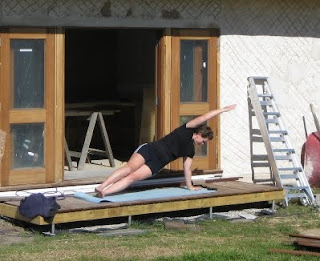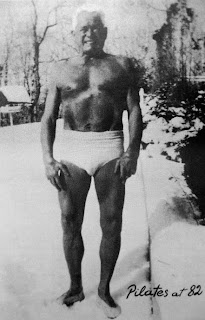The Age ran
an article yesterday under the headline
"Farmers' voice needs to be loud and proud to bridge the city-country divide". The article was written by Deborah Bain, a Victorian wool grower who established
Farm Day - "an annual event in which a city family is matched to a farm family for a day of fun, friendship and understanding".
Bain's article focused on the "rural-urban divide" - which I agree is both real and problematic in Australia. But Bain lost me when she stated that Australian farmers are "among the best producers in the world - from an environmental and animal welfare position."
Surely, she can't be serious? Just scroll down to see some photos
from past Farm Days of Australian farming practices, and tell me if you honestly believe that this is the kind of environmentalism and animal welfare that Aussie farmers should be "loud and proud" about:
(Edited 8 May 2010: I have acquiesced to Deborah Bain's request to remove the Farm Day images from this post. The image above is from Wikimedia Commons).
Earlier in her article, Bain was complaining that "the consumer" is "easily manipulated by negative claims about farming practices." Maybe Bain needs to think a bit harder about
why people make negative claims about Australian farming practices.
Personally, I can't think of a positive word to say about the farmers near where I live (and this is not to say that I think farmers further afield are generally any better - although there are certainly notable exceptions, such as
Hazelcombe and
Milkwood farms).
Our local farmers' "management" practices give me the impression that they are, by and large, unobservant people who consistently act in ways that are harmful to their land and their animals.
Are times tough for farmers? Yes! But that's an integral part of the big picture: farmers experiencing severe stress (which is often exacerbated by the degraded state of their land) make decisions based on perceived necessity,
not on grounds of animal or environmental welfare.
For example, take this piece of formal advice from
Angus Australia regarding drought management for beef producers: "Be careful that the decision [to provide maintenance feed] is made on a rational examination of costs and returns". The implied message is: let your cattle go hungry if it's "rational" to do so.
My home is surrounded by severely over-grazed, compacted, weed-infested farms. The animals (mostly sheep and cattle) are treated like mobile lumps of unfeeling protein. For example, the sheep are typically shorn in winter (which is stressful for them). Black steers are left in paddocks on scorching hot days without a stick of shade (which is stressful for them). These ordinary farming practices are a cruel parody of "animal welfare".
And then there are the agricultural abominations of factory farming, live sheep exports, and mulesing. (I have zero sympathy for farmers who mules their sheep, which is a cruel practice. If you
"have to" flay lambs in order to prevent flystrike, then you're farming the wrong animals in the wrong place. Either move your farm, or grow something better suited to your environment - but don't tell me it's "animal welfare").
When I was 16 I did some work experience with a vet in rural NSW. During that time I learned that being a country vet was all about sex and death. The vet's job is basically to keep animals healthy enough to be reproduced, and/or killed, profitably. (Incidentally, I had the memorable experience of collecting a jar of bull semen that week - and let me tell you,
that stuff doesn't come from a supermarket shelf!)
I understand and accept that farming livestock involves certain "practicalities" - typically culminating in the slaughter of the animal. So why can't farming spokespeople like Deborah Bain just acknowledge this fact, and stop pretending that farming is about animal welfare? Or, better yet, why can't they stop
talking about animal welfare, and start
practising it?
As for the common refrain that (to quote one of the people who commented on Bain's article): "The vast majority of today's farmers are extremely conscious of environmental issues - after all, our land is our income source."
Well, yes, that may indeed be the case. But being
conscious of an issue is not the same thing as addressing that issue satisfactorily. After all, the vast majority of alcoholics are "extremely conscious" of alcohol - but that hardly means they handle alcohol responsibly.
And finally: earning income from a piece of land doesn't automatically make your land management practices good and/or sustainable. Heck, my great grandfather was a Welsh coal miner, and look what happened to his land-based income source. The Earth owes nobody an income.
As Jared Diamond observed in his book
Collapse, Australian farmers have been "mining" the Australian landscape for generations - to the extent that "many problems that could eventually become crippling in other First World countries and already are so in some Third World countries - such as overgrazing, salinization, soil erosion, water shortages, and man-made droughts - have already become severe in Australia" (p.379).
Below
are were some photos from Deborah Bain's pet project,
Farm Day. These agricultural scenes don't look like shining examples of animal welfare and environmental sustainability to me. Rather, they look like the mining of Australia.
(Edited 8 May 2010: Deborah Bain was upset about me using Farm Day images in this post, so I have replaced those images with links to the original images on the Farm Day website, and I've added some alternative images from other sources below).
A barren, overgrazed paddock:
(Image
removed at request of
Deborah Bain.
See
original image on FarmDay website.)
Cute children in a barren, overgrazed paddock:
(Image
removed at request of
Deborah Bain.
See
original image on FarmDay website.)
More cute children in yet another overgrazed paddock:
(Image
removed at request of
Deborah Bain.
See
original image on FarmDay website.)
Heavy machinery - totally unsustainable in the long term. Apparently this farmer hasn't embraced the looming reality of Peak Oil yet:
(Image
removed at request of
Deborah Bain.
See
original image on FarmDay website.)
*****
Below are a few Australian farming images to replace the ones that Deborah Bain didn't want me to share with you ...
Livestock transport: the journey to the abattoir (or to the dock, for sheep unfortunate enough to be shipped alive to the Middle East) is typically stressful for livestock.
Image source:
Live Export Shame
Native fauna and flora: I have never met a sheep farmer who doesn't regard the kangaroo as an enemy. Australian farmers are generally so tightly bound to their traditional British farming roots that they still (
after more than 200 years) generally treat the native Australian flora and fauna as foes to be destroyed and replaced. I have witnessed a typical kangaroo cull on a typical Aussie farm, whereby hundreds of roos are shot, and left to rot on the ground. This is
not animal welfare, nor is it a clever and sustainable way to live in the Australian environment.
The image below is from the roo cull in Belconnen in 2008. These roos were buried in a large pit.
Image source:
Kangaroo protection coalition
Factory farming: most chickens in Australia spend the majority of their lives in cramped cages that don't even allow birds the simple "luxury" of stretching their wings. Most pigs are treated just as cruelly. Most people wouldn't dream of treating a budgerigar or a dog in such a horrible way.
Image source:
No caged eggs
Exacerbating the problems of drought: "There is a huge amount of dust in the air from the dry conditions and farmers ploughing the soil when it is dry, hoping for some follow up rain".
Text and image source:
Wikimedia Commons
"Dust storm covers the city of Wagga Wagga reducing visibility to 2 kilometres. The dust storm was caused by strong winds moving though south-eastern Australia whipping up valuable top soil from drought affected paddocks" .
Text and image source:
Wikimedia Commons






















